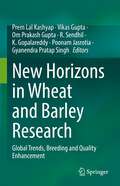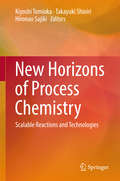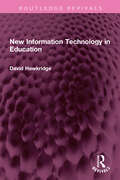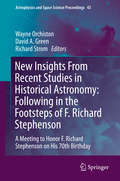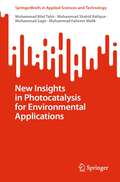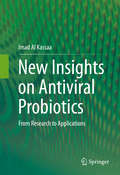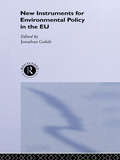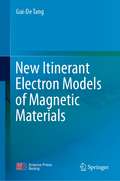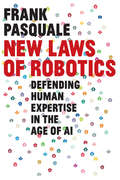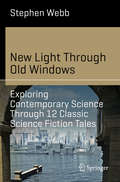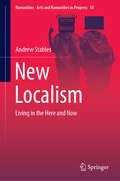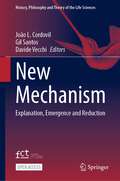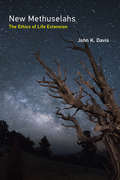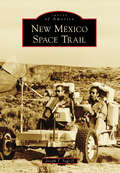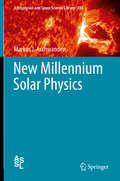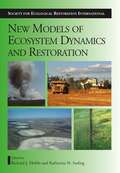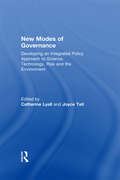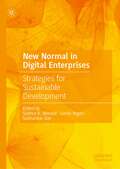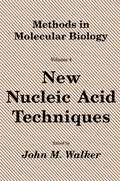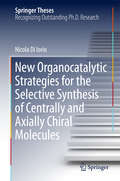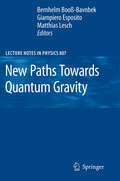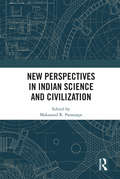- Table View
- List View
New Horizons in Wheat and Barley Research: Global Trends, Breeding and Quality Enhancement
by Vikas Gupta Prem Lal Kashyap Gyanendra Pratap Singh Om Prakash Gupta R. Sendhil K. Gopalareddy Poonam JasrotiaThis book outlines comprehensive information on the global trends, policies, research priorities and frontier innovations made in the research domain of breeding, biotechnology, biofortification and quality enhancement of wheat and barley. With contributions by international group of leading wheat and barley researchers, this book offers data-based insights along with a holistic view of the subject and serve as a vital resource of information for scientists engaged in breeding future high-yielding biofortified varieties. It catalogs both conventional as well as modern tools for gene identification and genome editing interventions for enhancing the yield, grain quality, disease and pest resistance, nutrient-use efficiency and abiotic stress tolerance. The prospects of processing high quality wheat end-products with long term storage and high nutritional quality are also discussed. This book is of interest to teachers, researchers, molecular breeders, cereal biochemists and biotechnologist, policymakers and professionals working in the area of wheat and barley research, food and cereal industry. Also, the book serves as an additional reading material for the undergraduate and graduate students of agriculture and food sciences. National and international agricultural scientists, policy makers will also find this book to be a useful read. Volume 2 of New Horizons in Wheat and Barley Research covers topics in crop protection and resource management.
New Horizons of Process Chemistry
by Takayuki Shioiri Kiyoshi Tomioka Hironao SajikiThe methodologies and technologies adaptable to process chemistry are the focus of this unique book, as new catalysts, reactions, and methods for the synthesis of functional materials are dealt with in depth for the first time. Those materials take in pharmaceuticals, agrochemicals, functional materials, chemical raw materials, and other substances in the field of process chemistry including green chemistry. Process chemistry underpins the competitiveness of chemical and pharmaceutical industries, but its stagnation is estimated to cause industrial depression and excessive loss. For that reason, chemists focus on process chemistry consistently so that the development of novel and efficient new reactions and technologies provides an essential stimulus. In addition, this volume describes the important development of selected new synthetic devices for process development and the process design for a larger scale, thus furnishing a valuable source for all who are engaged in process chemistry.
New Information Technology in Education (Routledge Revivals #32)
by David HawkridgeFirst published in 1983, New Information Technology in Education surveyed developments in the field of information technology and demonstrated how it could be used to improve the quality of education. The book considered the experience of a wide range of countries, including the United States, Japan and those in Europe. While explaining the potential improvements that the new technology could bring, this book also reviewed the problem areas and helped educationalists to evaluate the relevance of the new technology for their own work. In an age of teaching via Zoom videos, it is interesting to take a look at a time when information technology in education was at its nascent stage. This book will be of interest to teachers and students of history, education, technology and pedagogy.
New Insights From Recent Studies in Historical Astronomy: Following in the Footsteps of F. Richard Stephenson
by Wayne Orchiston David A. Green Richard StromThis book contains papers from a conference held to celebrate the 70th birthday of one of the world's foremost astronomical historians, Professor F. Richard Stephenson, the latest recipient of the American Astronomical Society's highest award for research in astronomical history, the LeRoy Doggett Prize. Reflecting Professor Stephenson's extensive research portfolio, this book brings together under one cover papers on four different areas of scholarship: applied historical astronomy (which Stephenson founded); Islamic astronomy; Oriental astronomy and amateur astronomy. These papers are penned by astronomers from Canada, China, England, France, Georgia, Iran, Japan, Lebanon, the Netherlands, Portugal, Thailand and the USA Its diverse coverage represents a wide cross-section of the history of astronomy community. Under discussion are ways in which recent research using historical data has provided new insights into auroral and solar activity, supernovae and changes in the rotation rate of the Earth. It also presents readers with results of recent research on leading historical figures in Islamic and Oriental astronomy, and aspects of eighteenth and nineteenth century Australian, British, German and Portuguese amateur astronomy, including the fascinating 'amateur-turned-professional syndrome'.
New Insights in Photocatalysis for Environmental Applications (SpringerBriefs in Applied Sciences and Technology)
by Muhammad Sagir Muhammad Bilal Tahir Muhammad Shahid Rafique Muhammad Faheem MalikThis book explains the basic and fundamental aspects of nanotechnology and the potential use of nanostructured photocatalysts in various applications, especially in the context of the environment and energy harvesting. It describes the preparation and characterization of unique nanostructured photocatalysts and provides details of their catalytic action, and also discusses the design of new types of photocatalysts with controlled nanostructures. Given its broad scope, the book will appeal to academic and industrial researchers interested in heterogeneous photocatalysis, sustainable chemistry, energy conversion and storage, nanotechnology, chemical engineering, environmental protection, optoelectronics, sensors and surface and interface science.
New Insights on Antiviral Probiotics
by Imad Al KassaaThis book focuses on probiotics with antiviral activities. The "antiviral probiotic" is a new concept in medical sciences. Recently, studies have shown that antiviral probiotics can fight or prevent viral infections in many ways. The immunomodulation of mucosal immunity, production of antiviral compounds, virus trapping and the use thereof as vaccination vectors are the principal modes of action of antiviral probiotics. The author dedicates an entire chapter of the book to discussing the methods and techniques used to assess the antiviral activity of probiotic strains and their metabolites.
New Instruments for Environmental Policy in the EU (Routledge/eui Studies In Environmental Policy Ser.)
by Jonathan GolubNew Instruments for Environmental Policy in the EU provides a comprehensive analysis of the debate over new forms of environmental regulation in the European Union.The conclusions draw attention to critical aspects of instrument design, as well as the difficulty of accommodating national policy diversity without contravening EU and international tr
New Issues in Polar Tourism
by Dieter K. Müller Linda Lundmark Raynald H. LemelinNew Issues in Polar Tourism traces and analyzes a decade of growing interest in the polar regions, and the consequent challenges and opportunities of increasing tourist traffic in formerly remote and seldom-visited places. The book arises from the recently-formed International Polar Tourism Research Network (IPTRN), and documents the outcomes of its 2010 conference, held at Sweden's Abisko Scientific Research Station.
New Itinerant Electron Models of Magnetic Materials
by Gui-De TangThis book highlights a series of new itinerant electron models proposed based on the experimental results of electron spectra obtained since 1970. Although conventional magnetic ordering models were established before 1960, many problems remain to be solved. The new models in this book include an O 2p itinerant electron model for magnetic oxides, a new itinerant electron model for magnetic metals, and a Weiss electron pair model for the origin of magnetic ordering energy of magnetic metals and oxides. With these models, the book explains typical magnetic ordering phenomena including those that cannot be explained using conventional models. These new models are easier to understand than the conventional magnetic ordering models.
New Laws of Robotics: Defending Human Expertise In The Age Of Ai
by Frank PasqualeAI is poised to disrupt our work and our lives. We can harness these technologies rather than fall captive to them—but only through wise regulation.Too many CEOs tell a simple story about the future of work: if a machine can do what you do, your job will be automated. They envision everyone from doctors to soldiers rendered superfluous by ever-more-powerful AI. They offer stark alternatives: make robots or be replaced by them.Another story is possible. In virtually every walk of life, robotic systems can make labor more valuable, not less. Frank Pasquale tells the story of nurses, teachers, designers, and others who partner with technologists, rather than meekly serving as data sources for their computerized replacements. This cooperation reveals the kind of technological advance that could bring us all better health care, education, and more, while maintaining meaningful work. These partnerships also show how law and regulation can promote prosperity for all, rather than a zero-sum race of humans against machines.How far should AI be entrusted to assume tasks once performed by humans? What is gained and lost when it does? What is the optimal mix of robotic and human interaction? New Laws of Robotics makes the case that policymakers must not allow corporations or engineers to answer these questions alone. The kind of automation we get—and who it benefits—will depend on myriad small decisions about how to develop AI. Pasquale proposes ways to democratize that decision making, rather than centralize it in unaccountable firms. Sober yet optimistic, New Laws of Robotics offers an inspiring vision of technological progress, in which human capacities and expertise are the irreplaceable center of an inclusive economy.
New Light Through Old Windows: Exploring Contemporary Science Through 12 Classic Science Fiction Tales (Science and Fiction)
by Stephen Webb<p>This book presents the reader with some of the earliest classic SF short stories – all of them published between 1858 and 1934, featuring both well-known and long-forgotten writers – dealing for the first time with topics to which science had (some) answers only at much later stages. This includes aspects of alien life forms, transmogrification, pandemics, life on Mars, android robots, big data, matter transmission and impact events to name but a few. <p>The short stories are reprinted in full alongside extensive commentaries which also examine some of the latest scientific thinking surrounding the story’s main theme and provide the reader with suggestions for further reading.</p>
New Localism: Living in the Here and Now (Numanities - Arts and Humanities in Progress #10)
by Andrew StablesThis book examines “New Localism' – exploring how communities have turned towards more local concerns: my street, my town, my state, as an expression of dissatisfaction with globalization. It details the ideas that have created a political force that academics have often misunderstood and provides a template for further investigation with a strong focus on how to harness the motivations behind such changes for the benefit of individuals, communities and the more-than-human environment.The book discusses human progress, both individual and collective, in terms of the interactions of the local and the global, the specific and the universal, and the concrete and the abstract. It also considers how forms of social progress can be understood and reconfigured in the context of the rejection of certain aspects of liberal intelligentsia orthodoxy over recent years.Developing his arguments with specific reference to the evolving, political landscape, the author helps readers to understand major events such as the Trump presidency and the British vote to leave the EU from a fully semiotic perspective. He also explains how educational processes can use and respond to such events in ways that are locally grounded but nevertheless not at odds with more abstract formulations of progress such as sustainability and social justice.
New Mechanism: Explanation, Emergence and Reduction (History, Philosophy and Theory of the Life Sciences #35)
by Davide Vecchi João L. Cordovil Gil SantosThis open access book addresses the epistemological and ontological significance as well as the scope of new mechanism. In particular, this book addresses the issues of what is "new" about new mechanism, the epistemological and ontological reasons underlying the adoption of mechanistic instead of other modelling strategies as well as the possibility of mechanistic explanation to accommodate a non-trivial notion of emergence. Arguably, new mechanism has been particularly successful in making sense of scientific practice in the molecular life sciences. But what about other sciences? This book enlarges the context of analysis, addressing the issue of the putative compatibility between the current ways of conceiving new mechanism and actual scientific practices in quantum physics, chemistry, biochemistry, developmental biology and the cognitive sciences.
New Methuselahs: The Ethics of Life Extension (Basic Bioethics)
by John K. DavisAn examination of the ethical issues raised by the possibility of human life extension, including its desirability, unequal access, and the threat of overpopulation. Life extension—slowing or halting human aging—is now being taken seriously by many scientists. Although no techniques to slow human aging yet exist, researchers have successfully slowed aging in yeast, mice, and fruit flies, and have determined that humans share aging-related genes with these species. In New Methuselahs, John Davis offers a philosophical discussion of the ethical issues raised by the possibility of human life extension. Why consider these issues now, before human life extension is a reality? Davis points out that, even today, we are making policy and funding decisions about human life extension research that have ethical implications. With New Methuselahs, he provides a comprehensive guide to these issues, offering policy recommendations and a qualified defense of life extension. After an overview of the ethics and science of life extension, Davis considers such issues as the desirability of extended life; whether refusing extended life is a form of suicide; the Malthusian threat of overpopulation; equal access to life extension; and life extension and the right against harm. In the end, Davis sides neither with those who argue that there are no moral objections to life enhancement nor with those who argue that the moral objections are so strong that we should never develop it. Davis argues that life extension is, on balance, a good thing and that we should fund life extension research aggressively, and he proposes a feasible and just policy for preventing an overpopulation crisis.
New Mexico Space Trail (Images of America)
by Joseph T. Page IIIn the Southwestern United States, the skies above New Mexico have provided an amazing stargazing experience for two millennia. Images of America: New Mexico Space Trail catalogs sites within the state that have inspired humankind to reach for the stars. The Space Trail includes various archaeoastronomy locations, such as Chaco Canyon, which Native Americans used to predict agricultural schedules according to the sun's position during the solstice. Rocket development in Roswell, missile launches in the Tularosa Basin, astronomy efforts around the state, and commercial space flights are just a few of the stops along the trail. Join the journey and discover night skies that are so dark that the Milky Way and its millions of luminous stars create shadows over the desert landscape.
New Millennium Solar Physics (Astrophysics and Space Science Library #458)
by Markus J. AschwandenThis is a follow-on book to the introductory textbook "Physics of the Solar Corona" previously published in 2004 by the same author, which provided a systematic introduction and covered mostly scientific results from the pre-2000 era. Using a similar structure as the previous book the second volume provides a seamless continuation of numerous novel research results in solar physics that emerged in the new millennium (after 2000) from the new solar missions of RHESSI, STEREO, Hinode, CORONAS, and the Solar Dynamics Observatory (SDO) during the era of 2000-2018. The new solar space missions are characterized by unprecedented high-resolution imaging, time resolution, spectral capabilities, stereoscopy and tomography, which reveal the intricate dynamics of magneto-hydrodynamic processes in the solar corona down to scales of 100 km. The enormous amount of data streaming down from SDO in Terabytes per day requires advanced automated data processing methods. The book focuses exclusively on new research results after 2000, which are reviewed in a comprehensive manner, documented by over 3600 literature references, covering theory, observations, and numerical modeling of basic physical processes that are observed in high-temperature plasmas of the Sun and other astrophysical objects, such as plasma instabilities, coronal heating, magnetic reconnection processes, coronal mass ejections, plasma waves and oscillations, or particle acceleration.
New Models for Ecosystem Dynamics and Restoration (Science Practice Ecological Restoration)
by Richard J. Hobbs Barbara H. Allen-Diaz Katharine N. Suding Peter Society for Ecological Restoration International Peter CaleAs scientific understanding about ecological processes has grown, the idea that ecosystem dynamics are complex, nonlinear, and often unpredictable has gained prominence. Of particular importance is the idea that rather than following an inevitable progression toward an ultimate endpoint, some ecosystems may occur in a number of states depending on past and present ecological conditions. The emerging idea of "restoration thresholds" also enables scientists to recognize when ecological systems are likely to recover on their own and when active restoration efforts are needed. Conceptual models based on alternative stable states and restoration thresholds can help inform restoration efforts. New Models for Ecosystem Dynamics and Restoration brings together leading experts from around the world to explore how conceptual models of ecosystem dynamics can be applied to the recovery of degraded systems and how recent advances in our understanding of ecosystem and landscape dynamics can be translated into conceptual and practical frameworks for restoration. In the first part of the book, background chapters present and discuss the basic concepts and models and explore the implications of new scientific research on restoration practice. The second part considers the dynamics and restoration of different ecosystems, ranging from arid lands to grasslands, woodlands, and savannahs, to forests and wetlands, to production landscapes. A summary chapter by the editors discusses the implications of theory and practice of the ideas described in preceding chapters. New Models for Ecosystem Dynamics and Restoration aims to widen the scope and increase the application of threshold models by critiquing their application in a wide range of ecosystem types. It will also help scientists and restorationists correctly diagnose ecosystem damage, identify restoration thresholds, and develop corrective methodologies that can overcome such thresholds.
New Modes of Governance: Developing an Integrated Policy Approach to Science, Technology, Risk and the Environment
by Catherine LyallIn modern global economies, how can we govern science, technology, risk and the environment more effectively? As the pace of innovation has increased, the governance agenda has, itself, been changing; policy-making is in a state of flux and governments are stressing the need for more integrated or "joined up" policies to deal with new orders of complexity. This timely book describes the new approaches to policy for science, technology, risk and the environment in the context of this modern governance agenda. The authors examine the extent to which governance is integrated, where gaps exist and where further integration might be helpful for a range of policy areas. The interdisciplinary approach bridges scientific, technical and socio-economic research at global, European, UK and regional levels. New Modes of Governance will be a valuable resource for academics, policy-makers, regulators, and science and industry communities involved in innovation.
New Normal in Digital Enterprises: Strategies for Sustainable Development
by Subhankar Das Subhra R. Mondal Ceren YegenThis book discusses the significance of descriptive, predictive, and prescriptive digital enterprises and their practices for different functional domains and in different countries during COVID-19. It explores new dimensions in digital enterprises that are emerging after COVID-19. Varied topics discussed include virtual workplace and workflows, media use, digital security, e-governance, digital supply chains, increased use of AI, new HR practices, and sustainable development in post-pandemic era. The broad range of digital development topics will help business owners, digital professionals, managers, researchers, and academicians.
New Organocatalytic Strategies for the Selective Synthesis of Centrally and Axially Chiral Molecules (Springer Theses)
by Nicola Di IorioThis thesis discusses the use of asymmetric organic catalysis for the direct enantioselective synthesis of complex chiral molecules, and by addressing the many aspects of both vinylogy and atropisomerism, it appeals to researchers and scholars interested in both areas.Organocatalysis is a relatively modern and “hot” topic in the chemical community; it is constantly expanding and its use has been extended to interesting areas like vinylogous reactivity and atropisomerism. Vinylogous systems are very important for their synthetic applications but also pose a number of challenges, the most notable of which are their reduced reactivity and the reduced stereocontrol at these positions. On the other hand, atropisomeric systems are even more important because of the huge potential they have as drugs, ligands and catalysts. Chemists have only recently “recognized” the importance of these two areas and are focusing their efforts on studying them and the challenges they pose. This thesis offers an extensive introduction on the general aspects of chirality and organocatalysis and an equally extensive experimental section that allow nonexperts to understand the discussion section and reproduce the experiments.
New Paths Towards Quantum Gravity
by Bernhelm Booß-Bavnbek G. Esposito Matthias LeschAside from the obvious statement that it should be a theory capable of unifying general relativity and quantum field theory, not much is known about the true nature of quantum gravity. New ideas - and there are many of them for this is an exciting field of research - often diverge to a degree where it seems impossible to decide in which of the many possible direction(s) the ongoing developments should be further sustained. The division of the book in two (overlapping) parts reflects the duality between the physical vision and the mathematical construction. The former is represented by tutorial reviews on non-commutative geometry, on space-time discretization and renormalization and on gauge field path integrals. The latter one by lectures on cohomology, on stochastic geometry and on mathematical tools for the effective action in quantum gravity. The book will benefit everyone working or entering the field of quantum gravity research.
New Perspectives in Indian Science and Civilization
by Makarand ParanjapeThis book examines key aspects of the history, philosophy, and culture of science in India, especially as they may be comprehended in the larger idea of an Indian civilization. The authors, drawn from a range of disciplines, discuss a wide array of issues — scientism and religious dogma, dialectics of faith and knowledge, science under colonial conditions, science and study of grammar, western science and classical systems of logic, metaphysics and methodology, and science and spirituality in the Mahabharata. This collection of essays aims to evolve a framework in which science, culture, and society in India may be studied fruitfully across disciplines and historical periods. With its diverse themes and original approaches, the book will be of interest to scholars and researchers in the fields of the history and philosophy of science, science and religion, cultural studies and colonial studies, philosophy and history, as well as India studies and South Asian studies.
New Perspectives in Regeneration
by David L. Stocum Ellen Heber-KatzRegeneration, the homeostatic ability to maintain tissue structure in the face of normal cell turnover or loss of tissue damaged by trauma or disease, is an essential developmental process that continues throughout life. As recently as a decade ago, any serious discussion of the possibility of regeneration becoming a practical medical tool in the near future had the air of science fiction or over-optimistic speculation. The term "regenerative medicine" was certainly on many lips but few actually expected to soon see it applied in a clinical setting. A tidal wave of discovery has changed that and investigating the cellular mechanisms of natural regeneration has become one of the hottest topics in developmental biology and biomedicine in general. Many researchers entering the field find that the regeneration literature is still quite diffuse perhaps owing to the disparate biological systems that have been the object of study including hydra, planaria, newts, axolotls and more recently several mouse strains. The volume editors believe that an attempt to organize or systematize the literature is long overdue. In this volume, respected experts highlight the latest findings in vertebrate (including mammals) wound healing and regeneration. They present eleven reviews that cover a wide range of topics, from wound repair and its relationship to regeneration, through systems including lenticular, neural, and musculoskeletal tissues and limbs, to epigenetics and the role of the cell cycle. Nuclear reprogramming and cellular plasticity, which open the door for potential regenerative medical therapies for injury and degenerative disease, are recurring themes throughout the book. We are all now part of the regeneration revolution.
